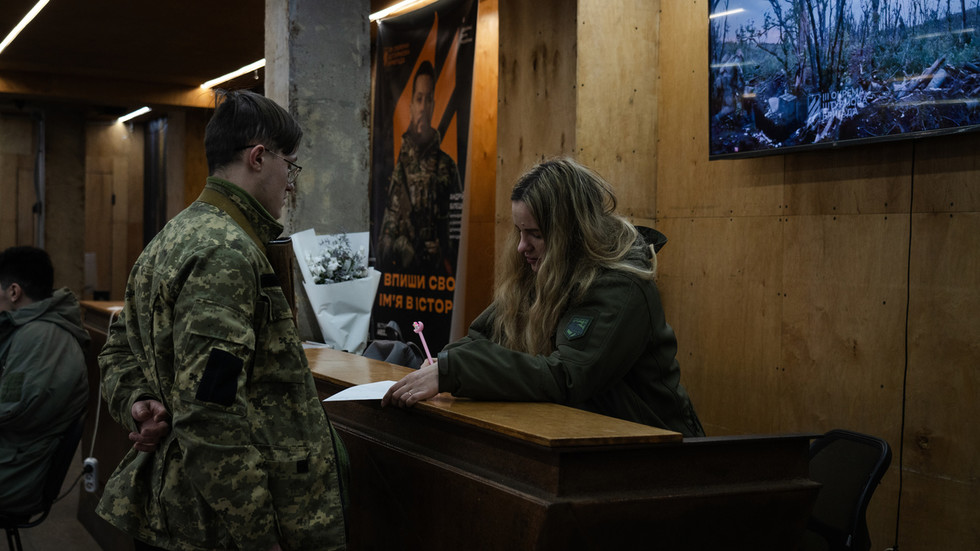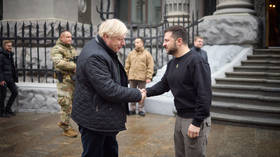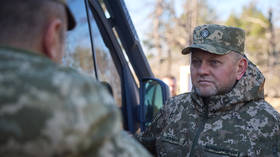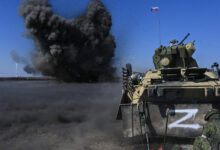
Here’s why Kiev’s mobilization reform will only delay the inevitable

By Sergey Poletaev, information analyst and publicist, co-founder and editor of the Vatfor project.
By Sergey Poletaev, information analyst and publicist, co-founder and editor of the Vatfor project.
Vatfor project

FILE PHOTO: A military officer from the third separate assault brigade is seen doing recruitment job in Kyiv region. © Ashley Chan / SOPA Images / LightRocket via Getty Images
In the past year, we’ve seen countless videos showing men in Ukraine being violently grabbed and drafted into the army. ‘Hard men’ in military uniforms are frequently seen rounding up civilians on the streets to the accompanying tears and screams of women, often brutally beating the future servicemen right in front of cameras. It seems that the workers of the military enlistment offices (Territorial Recruitment Centers, or TRCs) act indiscriminately. They just catch random people on the street, including fathers of many children, and even disabled people.
Mobilization in Ukraine resembles a safari. For example, in one video, we see a man being chased by a car like an animal. In an attempt to save his life, he jumps over a high fence. A man who was watching this scene hid in an attic. Another male almost drowned in an attempt to cross a river on the border with Moldova.
However, not all Ukrainian men are so unlucky – various videos on the internet show that there are plenty of them in big cities. We see them sitting in cafes, walking the streets, working, driving, and riding trains. So why aren’t they at the front?
In order to answer this question, the Ukrainian authorities have adopted a new law on mobilization, which will come into force on May 18. Most of the innovations prescribed in the new law concern greater control over the registration of conscripts. The new rules are supposed to help the Ukrainian Army system easily find them instead of grabbing guys off the streets, as in the scandalous videos.
Within 60 days of the law coming into effect, all Ukrainian men aged between 18 and 60 (including those who live abroad) will have to update their military registration data. Men who are not registered for service won’t be able to get a passport or access consular services. In addition, the law restricts “draft evaders” from working in the civil service, and allows TRCs to deprive them of a driver’s license through a court ruling. The fines for violating the mobilization law will also increase tenfold.

Read more
Why was this drastic law necessary? And will it improve the situation for the Ukrainian Armed Forces (AFU) or only delay an inevitable defeat?
The remnants of Soviet civilization
At the time of the USSR’s collapse, the Kiev Military District was among the most advanced and combat-ready in the Soviet Union. It had the latest weapons, some of the biggest stocks of ammunition and armored vehicles, and many of the best officers of the Soviet Army were sent to serve there.
For the sake of better understanding, a few words must be said about the Soviet army recruitment system. In peacetime, units were mainly comprised of officers and a minimal number of soldiers who maintained military equipment for combat readiness. In the event of war, within a matter of days, these units were to be filled with reservists who had completed their mandatory military service after school or college.
With the collapse of the Soviet Union in 1991, this system rapidly fell apart. In 2013, conscription in Ukraine was suspended, but after the Western-backed 2014 Kiev coup, it was restored. However, the system didn’t work. Between 2014 and 2022, the AFU consisted mainly of men serving under contract, and by February 2022, the Ukrainian Army reserve was made up of veterans of the so-called Anti-Terrorist Operation (ATO) in Donbass. According to various estimates, in eight years, up to 350,000 people participated in the ATO and gained practical combat experience.
Meanwhile, compulsory military service and the training of reservists in Ukraine existed merely on paper. Theoretically, all young men had to serve in the army, but in practice almost every potential conscript in Ukraine paid a bribe, and their military personnel file was either “lost” or didn’t even exist (if the bribe was given by the subject’s parents while he was still at school). And if a guy was registered for military service, it was easy to make sure his address of registration and place of residence didn’t match.
In rural areas, draft evasion has been less common, and people are more likely to reside at the address that was stated in their documents. That is why there are few men left in certain Ukrainian villages – because so many have been conscripted into the army. The Western press occasionally talks about such situations, but in general, this is a rare phenomenon.
After the beginning of the Russian offensive and martial law, Ukrainian military enlistment offices had to draft people into the army. At first, there were no problems, since there were plenty of volunteers. In the early days of the war, when patriotic enthusiasm was still strong, men lined up to join the AFU. The last volunteer brigades were formed in the winter of 2022-23 to participate in the Ukrainian counteroffensive which was being prepared at that time (in particular, the rather famous 47th Brigade was put together around then), but subsequently the influx of volunteers almost completely stopped.

Read more
Gradually, the lists of registered conscripts and reservists who had participated in the ATO were exhausted. There was simply no one to send summonses to, since most Ukrainian men weren’t registered for military service and enlistment offices had no information about them.
However, the front required constant replenishment, and the AFU didn’t alter its mobilization plan. For this reason, the authorities resorted to raids and caught people on the streets, while military commissars complained about the failed recruitment system. The whole point of the new reform is to register all Ukrainian men, and strip those who refuse to be registered of many of their rights.
AFU Commander-in-Chief Aleksandr Syrsky recently complained about the difficult period which Ukraine is about to enter. He understands that the situation cannot be reversed in a month or two – it will take time to register all the men and send them to the front.
For this reason too, Ukrainian officials are worried about a potential Russian offensive this summer. Most likely, Moscow will not change its strategy but, utilizing its numerical advantage and superior firepower, will continue to push at different sections of the front. In the event of a breakthrough in some area, it will send reserves to that spot and take advantage of the situation.
In this regard, Ocheretino is a good example. As Ukrainian forces become depleted, the AFU’s defense may fail, and it may lose not just one brigade, but several. That is why there’s been a lot of talk about the potentially imminent loss of what Kiev still holds in Donbass.
The funnel of disaster
In an extreme scenario, Russia’s strategy could lead to a situation similar to the Hundred-Days Offensive of the Entente in 1918. Back then the German army just fell apart. Even though there were few impressive breakthroughs, and the Kaiser’s troops weren’t encircled and Berlin held its cities, the war ended with Germany’s surrender.
Kiev fears this scenario and, in order to prevent a total collapse of the front, it needs mobilization reform. Even if it doesn’t go entirely according to plan, the changes will bring certain results, since currently, there are plenty of men who won’t voluntarily join the army but are not prepared to live as outlaws either.
We may assume that the AFU will manage to recruit up to 100,000. This will be sufficient to replenish the troops, form several new brigades, reinforce the front, or stop breakthroughs of the front line (like the current one in Kharkov Region). However, the Russian Army still has numerical advantage and much greater replenishment potential, not to mention superior firepower.
In addition to quantity, another important issue is the quality of the servicemen. Even Ukrainian figures (which underestimate the situation) show that about 30,000 people sign up for contract service in the Russian Army every month. For a second year in a row, there are queues at Russia’s military enlistment offices.
As we noted above, Ukraine ran out of volunteers last year. Most of them were either reservists who had fought in Donbass or enthusiastic Ukrainian patriots. Moreover, numbers show that even if the number of volunteers in Russia and Ukraine were the same, the fact that Russia’s population is five times greater than Ukraine’s speaks for itself.

Read more
Moreover, people who have been forcefully mobilized into the army may be able to maintain a static defense, but they aren’t prepared for active combat – such as participating in counterattacks and stopping breakthroughs, not to mention assault operations.
Another serious problem for the AFU is that many men refuse to fight. As a result, certain units have fallen apart to the point of losing their combat capability. Many servicemen also bribe commanders to avoid being sent to the front line. The morale of Ukrainian troops seems to be deteriorating, and it is unlikely that the mobilization reform will solve the problem.
For the time being, the AFU in general is still combat-ready and the West continues to supply it with military equipment. Most likely, the front will not collapse during this year’s spring-summer campaign, and Kiev won’t capitulate. But either way, Ukraine is approaching a dead end – the country is growing weaker, and its army is becoming depleted. In fact, it may already have passed the point of no return, and neither Western aid nor increased mobilization will help it escape disaster.
However, this does not mean that Kiev and its Western sponsors will just sit and calmly wait for the inevitable. We’ll talk more about the options that they have in the next article.



